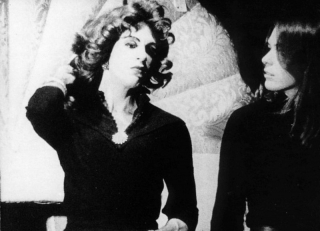Date: 14 June 2003 | Season: California Sound/California Image
HOLLYWOOD BE THY NAME
Saturday 14 June 2003, at 7pm
London Barbican Screen
Four of the avant-garde’s most momentous flirtations with the glamorous world of The Movies. The dark shadow of Tinseltown looms large on the horizon.
Robert Florey & Slavko Vorkapich, The Life and Death of 9413 – A Hollywood Extra, 1927, b/w, silent, 15 min
George Kuchar, I, An Actress, 1978, b/w, sound, 10 min
Andy Warhol, Hedy (The Shoplifter), 1966, b/w, sound, 66 min
Kenneth Anger, Puce Moment, 1949/70, colour, sound, 7 min
PROGRAMME NOTES
HOLLYWOOD BE THY NAME
Saturday 14 June 2003, at 7pm
London Barbican Screen
THE LIFE AND DEATH OF 9413 – A HOLLYWOOD EXTRA
Robert Florey & Slavko Vorkapich, 1927, b/w, silent, 15 min
“A Hollywood Extra was made by three people: Slavko Vorkapich, an expatriate Yugoslavian commercial artist turned cinéaste; Robert Florey, an expatriate French journalist; and Gregg Toland, an assistant cameraman at MGM. Shot over several weekends in Vorkapich’s kitchen at a total cost of $97, it combined live action and special effects to recount the fate of an extra who hopes to make a career as an actor, and also to sketch the conditions of studio production and the architectural fabric of the city at large. Hollywood dehumanises the hopeful actor and eventually destroys him. He is reduced to a number (which is written on his forehead), he fails to find work and, hounded by creditors and continually humiliated by the stars, he sinks into poverty and dies. Only when he reaches Heaven is the stigma removed from his brow.” —David E. James, Unseen Cinema
I, AN ACTRESS
George Kuchar, 1978, b/w, sound, 10 min
“This film was shot in 10 minutes with four or five students of mine at the San Francisco Art Institute. It was to be a screen test for a girl in the class. She wanted something to show producers of theatrical productions; the girl was interested in an acting career. By the time all the heavy equipment was set up the class was just about over; all we had was 10 minutes. Since 400 feet of film takes 10 minutes to run through the camera … that was the answer: Just start it and don’t stop till it runs out. I had to get into the act to speed things up so, in a way, this film gives an insight into my directing techniques while under pressure.” —George Kuchar
HEDY (THE SHOPLIFTER)
Andy Warhol, 1966, b/w, sound, 66 min
“Starring Mario Montez as ‘Hedy’, Mary Woronov as the policewoman, Harvey Tavel as the judge, Ingrid Superstar as the sales lady, Ronald Tavel as the walk-on, and the five husbands are played by Gerard Malanga, Rick Lockwood, James Claire, Randy Borscheidt, David Myers. Jack Smith plays the soothsayer. Arnold Rockwood, of Flaming Creatures fame, plays the surgeon. The story of a wealthy and beautiful woman getting a face-lifting to look more beautiful, and then caught at shop-lifting, to face her former five husbands and her past climbing up and down the ladder of success. Scenario by Ronald Tavel. Musical soundtrack by John Cale and Lou Reed.” —New York Film-Makers’ Cooperative Catalogue No.4
PUCE MOMENT
Kenneth Anger, 1949/70, colour, sound, 7 min
A fragment of the uncompleted feature film Puce Women. “Puce Women was my love affair with mythological Hollywood. A straight, heterosexual love affair, no bullshit, with all the great goddesses of the silent screen. They were to be filmed in their actual houses; I was, in effect, filming ghosts. When I couldn’t get any bread from [Arthur] Freed or [Gene] Kelly at MGM the project was doomed, because a freeway to the San Fernando Valley was put through all those lovely 1920 houses. That was a sad day for Hollywood, the beginning of the end, when Whitley Heights went. I’m a conservative, meaning that I cherish things of value. This places me at the antipodes of a cheap hustler like Andy Warhol, who is the garbage merchant of our time.” —Kenneth Anger interviewed by Tony Rayns
Back to top
